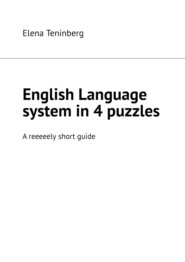скачать книгу бесплатно
English Language system in 4 puzzles. A reeeeely short guide
Elena Teninberg
I will tell you only one thing: it took me a half of my life to organize everything in this way. At one point I dared to turn my hobby of studying English into vocation. Now I am happy to introduce the system to you and wish you to reach your own goals by using English language as a second one.
English Language system in 4 puzzles
A reeeeely short guide
Elena Teninberg
© Elena Teninberg, 2023
ISBN 978-5-0060-6151-4
Created with Ridero smart publishing system
.
Dedicated to my family
Elena Teninberg
A reeeeeally Short Guide.
English Grammar in 4 puzzles.
I will tell you only one thing: it took me a half of my life to organize everything in this way. At one point I dared to turn my hobby of studying English into vocation. I did CELTA at the International House of London not being a native speaker and without any special linguistic education. Then this system was tested on thousands of students becoming more and more developed.
Now, I am happy to introduce the system to you and wish you to reach your own goals by using English language as a second one.
All rights reserved. No part of this book may be reproduced, stored in a retrieval system, or transmitted in any form or any means, electronic, mechanical, photocopying, recording or otherwise, without the prior permission in writing of the author.
This book is sold subject to the conditions that it shall not, by way of trade or otherwise, be lent, re-sold, hired out or otherwise circulated without the author’s prior consent in any form of binding or cover other than that in which it is published and without a similar condition including this condition being imposed on the subsequent purchaser.
Dear friends
Thank you for reading this book.
I do not think I know all of you, so I would better introduce myself. I am Elena Teninberg, a creator of the system how to deal with English language as a system in the most effective way.
Initially I studied English Language more as a hobby and an opportunity to work in global business companies, such as General Electric etc. At first it was not that easy, so I guess I can clearly know all the difficulties that an every person faces while studying the language. In the end I managed to organize all the rules in a logical system to make it as easy as possible. Sometimes it did not correspond with the widely applied scientific rules and principals. In a few minutes you will be introduced to a new hand-made concept of English language as a system.
I will tell you only one thing: it took me a half of my life to organize everything in this way. At one point I dared to turn my hobby of studying English into vocation. I did CELTA at the International House of London not being a native speaker and without any special linguistic education. Then this system was tested on thousands of students becoming more and more developed.
Now, I am happy to introduce the system to you and wish you to reach your own goals by using English language as a second one.
Let’s get started
I have divided my talk into the following sections: I will start off with types of verbs, then move on to formats, look briefly at types of time and finely tenses.
1. TYPES OF VERBS
To begin with, I would like to examine in some detail types of verbs.
To describe an action in English Language it is necessary to apply two verbs at a time. One of them, Constructing verb, is not translated directly, but helps to form question, negative/ positive affirmative forms of sentences, as well it is used to change the time of sentences. The second one, Representative verb, describes an action itself. Only a combination of these two verbs can bring the message.
2. FORMATS
Now, I want to move on to formats. Formats are unique combinations of two verbs: Constructing and Representative verb. In other words there are two distinctive features to identify a format.
Each format brings the idea whether an action is completed or not by the time of speaking.
There are four well known formats: Continuous, Simple, Perfect Continuous and Perfect Simple. Let’s take a look at them in more detail in the model of present time.
The combination, well known as Continuous, is used to describe a process in its progress. It is formed by Constructing verb BE (AM/ IS / ARE) plus Representative verb in —ing form. It is used to apply to a process not necessarily happening at the moment of speaking, but at the present period of time.
When we say, “The horse is grazing in a meadow”, we watch the process and can’t know for sure what the horse is going to do in a 5-minute time.
